NEW YORK (AP) — Yankees second baseman Gleyber Torres left Friday night's game against Boston after aggravating his right groin while beating out an infield hit that sparked a three-run fourth inning.
Torres hit a grounder that shortstop Ceddane Rafaela snagged with a dive. Rafaela got to his feet and threw to first, and Torres beat the throw to load the bases with one out in a scoreless game.
He immediately left the game and was replaced by Oswaldo Cabrera. New York went on to take a 3-0 lead.
Torres also left a June 20 game against Baltimore because of right groin tightness. The Yankees said he was examined at the stadium and there were no plans for imaging at this time.
Manager Aaron Boone said he did not think the injury was significant, but wasn't sure whether Torres will play Saturday.
Torres is hitting .223 with eight homers and 33 RBIs, but batted .308 (8 for 26) in his last seven games.
New York already was missing first baseman Anthony Rizzo, sidelined since June 16 by a broken forearm, and designated hitter Giancarlo Stanton, out since June 22 because of a strained hamstring.
AP MLB: https://apnews.com/hub/mlb

New York Yankees' Gleyber Torres (25) runs past Boston Red Sox's Romy Gonzalez, bottom, for a single during the fourth inning of a baseball game, Friday, July 5, 2024, in New York. Torres was injured on the play. (AP Photo/Frank Franklin II)
ASHEVILLE, N.C. (AP) — Nearly a week after Hurricane Helene brought devastation to western North Carolina, a shiny stainless steel tanker truck in downtown Asheville attracted residents carrying 5-gallon containers, milk jugs and buckets to fill with what has become a desperately scare resource — drinking water.
Flooding tore through the city’s water system, destroying so much infrastructure that officials said repairs could take weeks. To make do, Anna Ramsey arrived Wednesday with her two children, who each left carrying plastic bags filled with 2 gallons (7.6 liters) of water.
“We have no water. We have no power. But I think it’s also been humbling,” Ramsey said.
Helene’s path through the Southeast left a trail of power outages so large the darkness was visible from space. Tens of trillions of gallons of rain fell and more than 200 people were killed, making Helene the deadliest hurricane to hit the mainland U.S. since Katrina in 2005. Hundreds of people are still unaccounted for, and search crews must trudge through knee-deep debris to learn whether residents are safe.
It also damaged water utilities so severely and over such a wide inland area that one federal official said the toll “could be considered unprecedented.” As of Thursday, about 136,000 people in the Southeast were served by a nonoperational water provider and more than 1.8 million were living under a boil water advisory, according to the Environmental Protection Agency.
Western North Carolina was especially hard hit. Officials are facing a difficult rebuilding task made harder by the steep, narrow valleys of the Blue Ridge Mountains that during a more typical October would attract throngs of fall tourists.
“The challenges of the geography are just fewer roads, fewer access points, fewer areas of flat ground to stage resources” said Brian Smith, acting deputy division director for the EPA's water division in the Southeast.
After days without water, people long for more than just a sponge bath.
“I would love a shower,” said Sue Riles in Asheville. “Running water would be incredible.”
The raging floodwaters of Helene destroyed crucial parts of Asheville’s water system, scouring out the pipes that convey water from a reservoir in the mountains above town that is the largest of three water supplies for the system. To reach a second reservoir that was knocked offline, a road had to be rebuilt.
Boosted output from the third source restored water flow in some southern Asheville neighborhoods Friday, but without full repairs schools may not be able to resume in-person classes, hospitals may not restore normal operations, and the city’s hotels and restaurants may not fully reopen.
Even water that’s unfit to drink is scarce. Drew Reisinger, the elected Buncombe County register of deeds, worries about people in apartments who can’t easily haul a bucket of water from a creek to flush their toilet. Officials are advising people to collect nondrinkable water for household needs from a local swimming pool.
“One thing no one is talking about is the amount of poop that exists in every toilet in Asheville,” he said. “We're dealing with a public health emergency.”
It’s a situation that becomes more dangerous the longer it lasts. Even in communities fortunate enough to have running water, hundreds of providers have issued boil water notices indicating the water could be contaminated. But boiling water for cooking and drinking is time consuming and small mistakes can cause stomach illness, according to Natalie Exum, an assistant professor at Johns Hopkins Bloomberg School of Public Health.
“Every day that goes by, you could be exposed to a pathogen,” Exum said. “These basic services that we take for granted in our everyday lives actually do do a lot to prevent illness.”
Travis Edwards’ faucet worked immediately after the storm. He filled as many containers as he could for himself and his child, but it didn’t take long for the flow to weaken, then stop. They rationed water, switching to hand sanitizer and barely putting any on toothbrushes.
“(We) didn’t realize how dehydrated we were getting,” he said.
Federal officials have shipped millions of gallons of water to areas where people also might not be able to make phone calls or switch on the lights.
Power has been restored to about 62% of homes and businesses and 8,000 crews are out working to restore power in the hardest hit parts of North Carolina, federal officials said Thursday. In 10 counties, about half of the cell sites are still down.
The first step for some utilities is simply figuring out how bad the damage is, a job that might require EPA expertise in extreme cases. Ruptured water pipes are a huge problem. They often run beneath roads, many of which were crumpled and twisted by floodwaters.
“Pretty much anytime you see a major road damaged, there’s a very good chance that there’s a pipe in there that’s also gotten damaged,” said Mark White, drinking water global practice leader at the engineering firm CDM Smith.
Generally, repairs start at the treatment plant and move outward, with fixes in nearby big pipes done first, according to the EPA.
“Over time, you’ll gradually get water to more and more people,” White said.
Many people are still missing, and water repair employees don’t typically work around search and rescue operations. It takes a toll, according to Kevin Morley, manager of federal relations with the American Water Works Association.
“There’s emotional support that is really important for all the people involved. You’re seeing people’s lives just wiped out,” he said.
Even private well owners aren’t immune. Pumps on private wells may have lost power and overtopping floodwaters can contaminate them.
There’s often a “blind faith” assumption that drinking water won’t fail. In this case, the technology was insufficient, according to Craig Colten. Before retiring to Asheville, he was a professor in Louisiana focused on resilience to extreme weather. He hopes Helene will prompt politicians to spend more to ensure infrastructure withstands destructive storms.
And climate change will only make the problem more severe, said Erik Olson, a health and food expert at the nonprofit Natural Resources Defense Council.
“I think states and the federal government really need to step back and start looking at how we’re going to prepare for these extreme weather events that are going to be occurring and recurring every single year,” he said.
Edwards has developed a system to save water. He’ll soap dirty dishes and rinse them with a trickle of water with bleach, which is caught and transferred to a bucket — useable for the toilet.
Power and some cell service have returned for him. And water distribution sites have guaranteed some measure of normalcy: Edwards feels like he can start going out to see friends again.
“To not feel guilty about using more than a cup of water to, like, wash yourself … I’m really, really grateful,” he said.
Phillis reported from St. Louis. Associated Press writer Rebecca Santana contributed from Washington.
The Associated Press receives support from the Walton Family Foundation for coverage of water and environmental policy. The AP is solely responsible for all content. For all of AP’s environmental coverage, visit https://apnews.com/hub/climate-and-environment
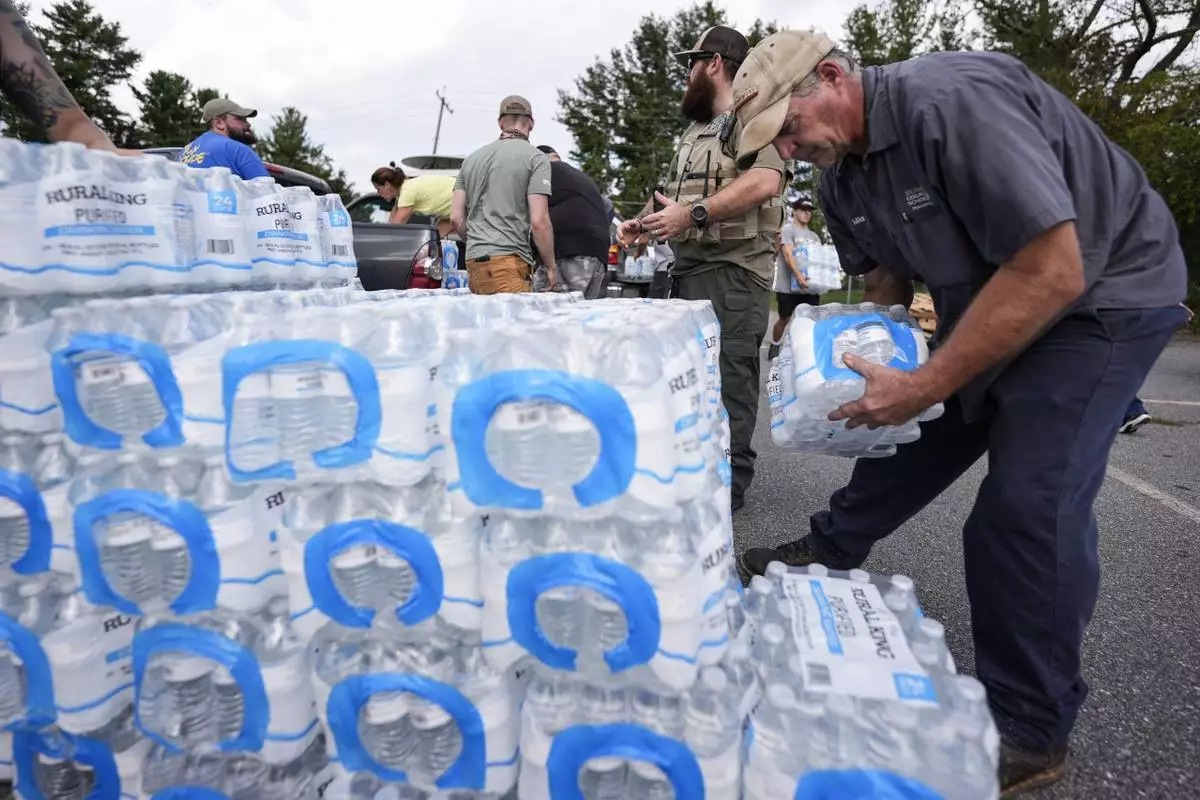
Volunteers stage water for people in the aftermath of Hurricane Helene, Monday, Sept. 30, 2024, in Asheville, N.C. (AP Photo/Mike Stewart)
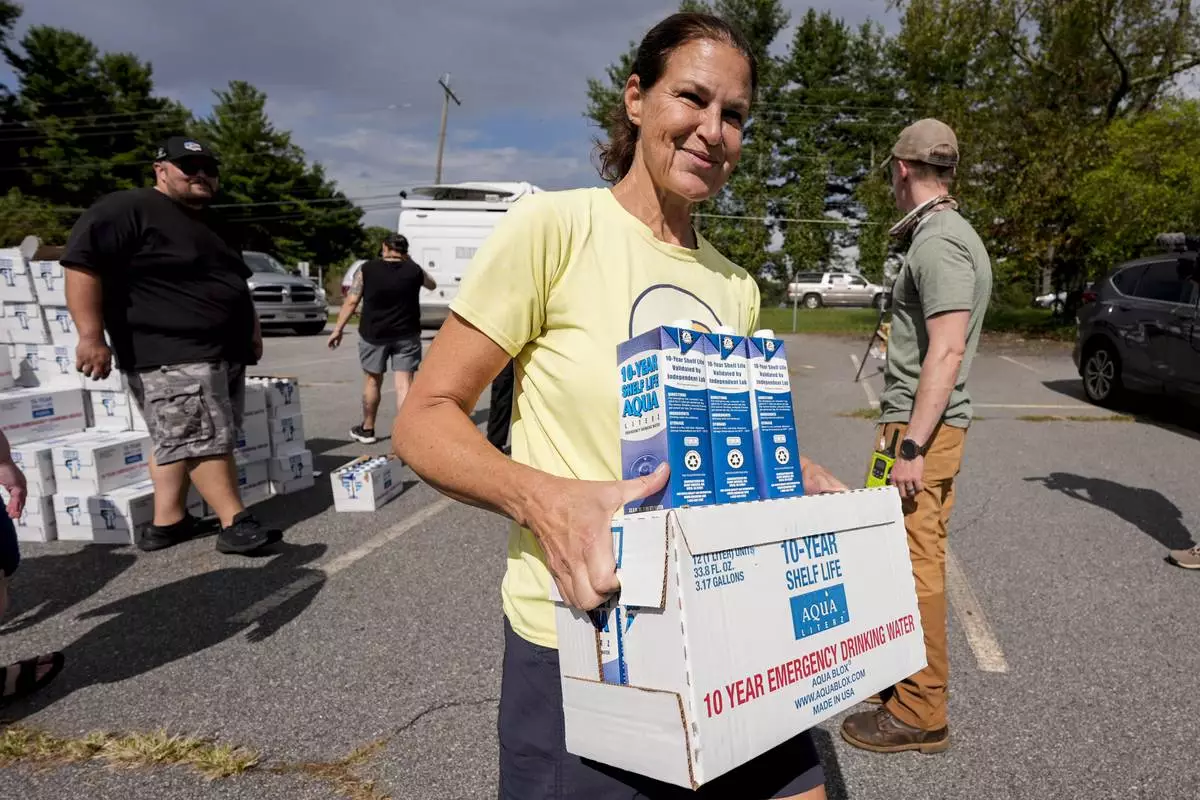
Volunteers stage water for citizens in the aftermath of Hurricane Helene, Monday, Sept. 30, 2024, in Asheville, N.C. (AP Photo/Mike Stewart)
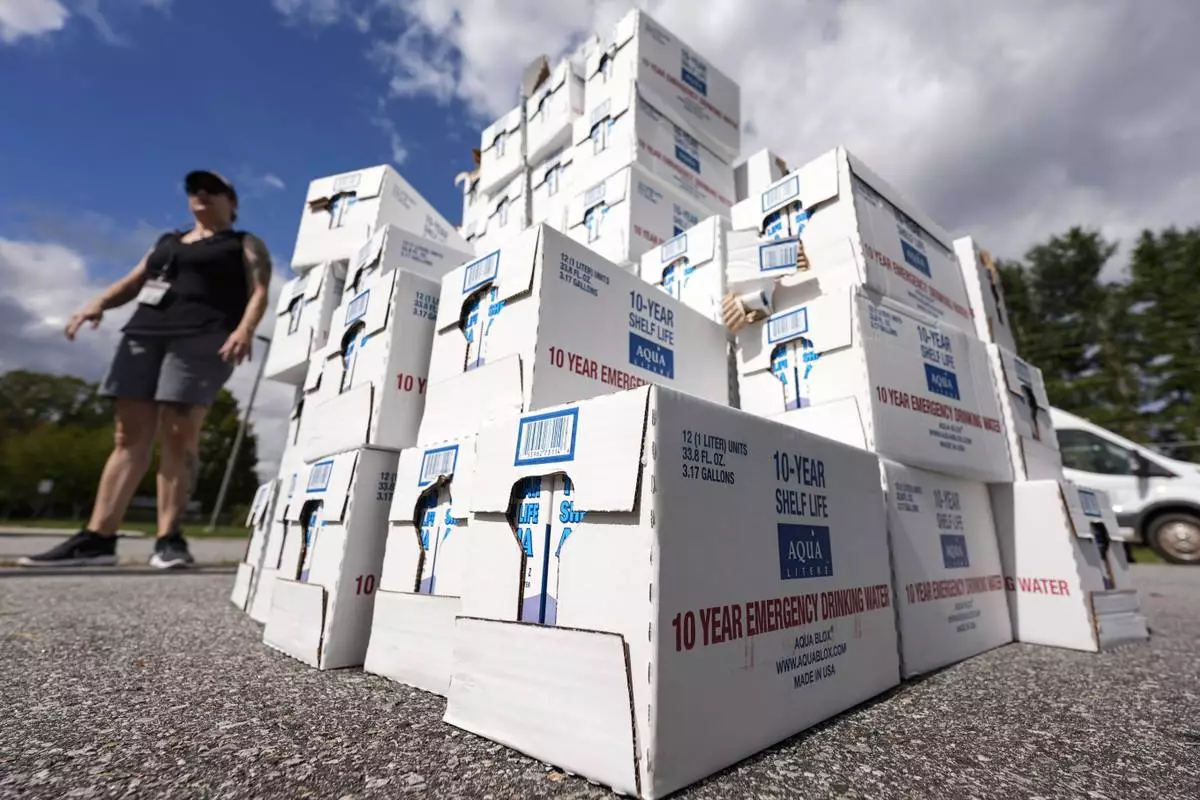
Volunteers stage water for citizens in the aftermath of Hurricane Helene, Monday, Sept. 30, 2024, in Asheville, N.C. (AP Photo/Mike Stewart)
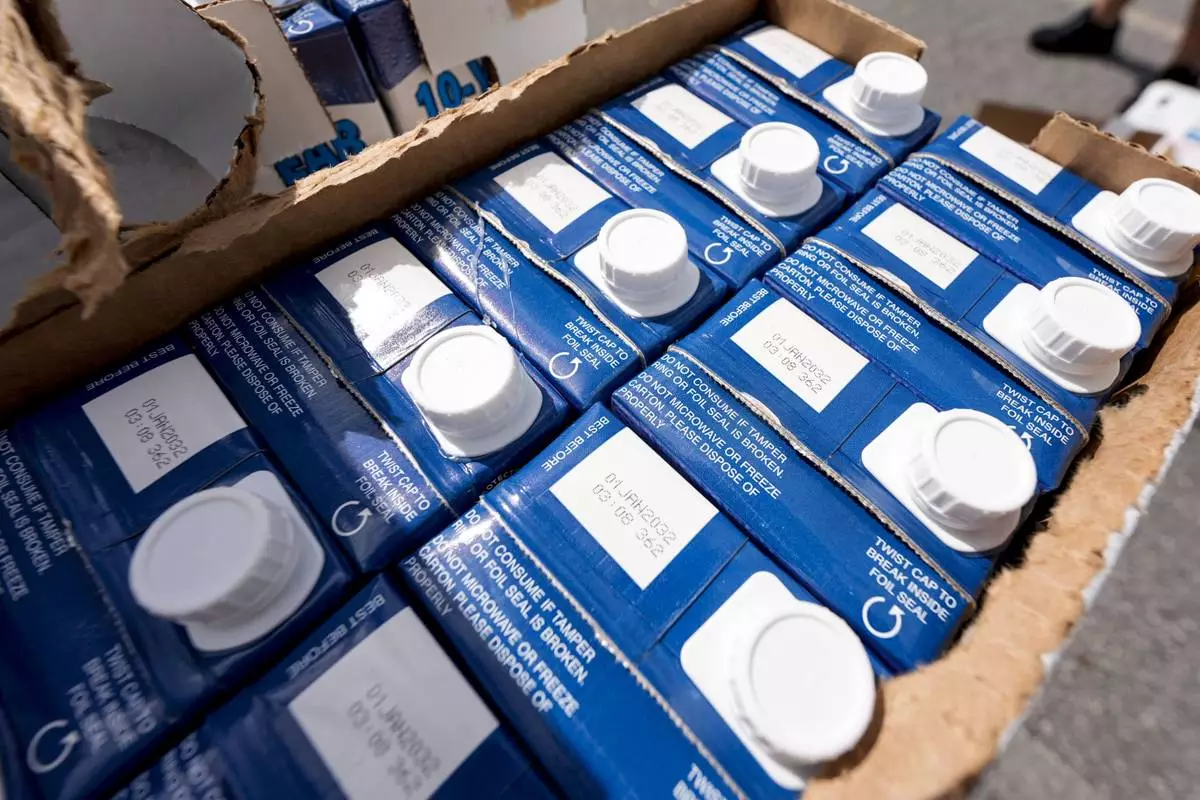
Volunteers stage water for citizens in the aftermath of Hurricane Helene, Monday, Sept. 30, 2024, in Asheville, N.C. (AP Photo/Mike Stewart)
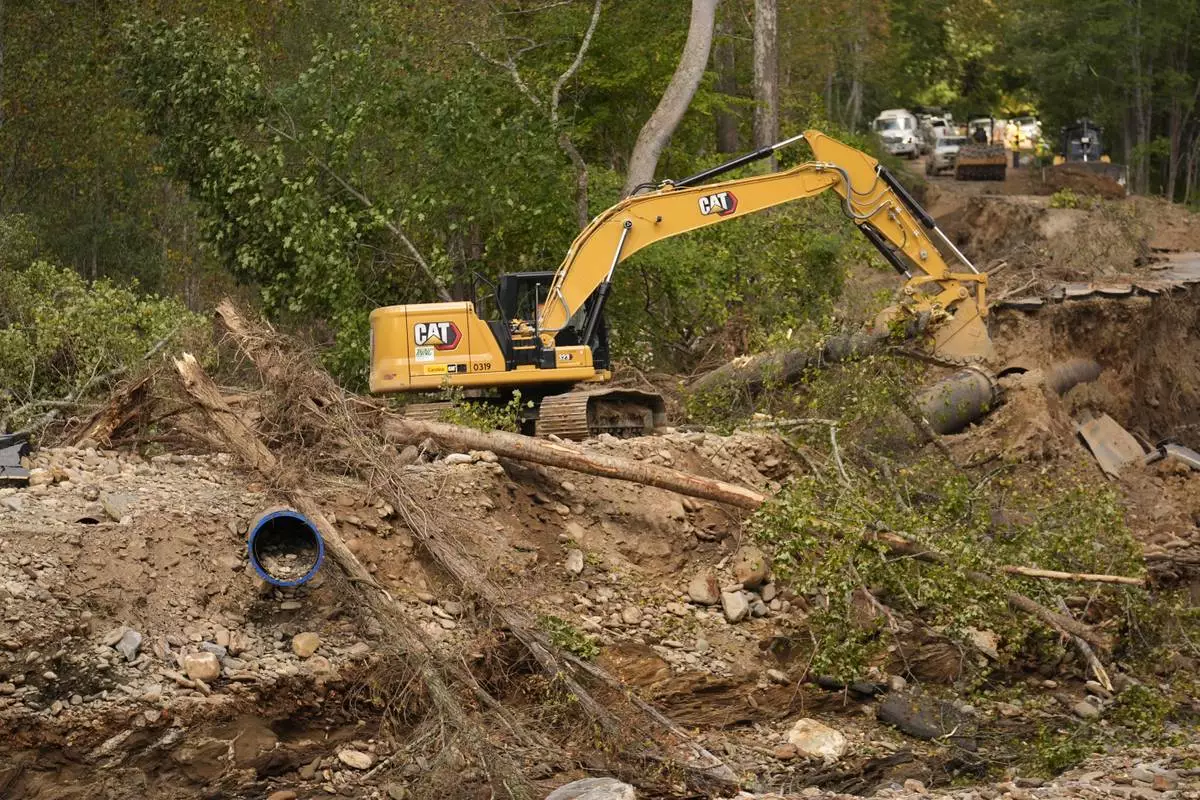
A backhoe is used to clear debris left by Hurricane Helene that washed away a road and destroyed a waterline for the city of Asheville Wednesday, Oct. 2, 2024, in Black Mountain, N.C. (AP Photo/Jeff Roberson)

Workers hand out fresh water at a distribution site in the aftermath of Hurricane Helene Wednesday, Oct. 2, 2024, in Asheville, N.C. (AP Photo/Jeff Roberson)
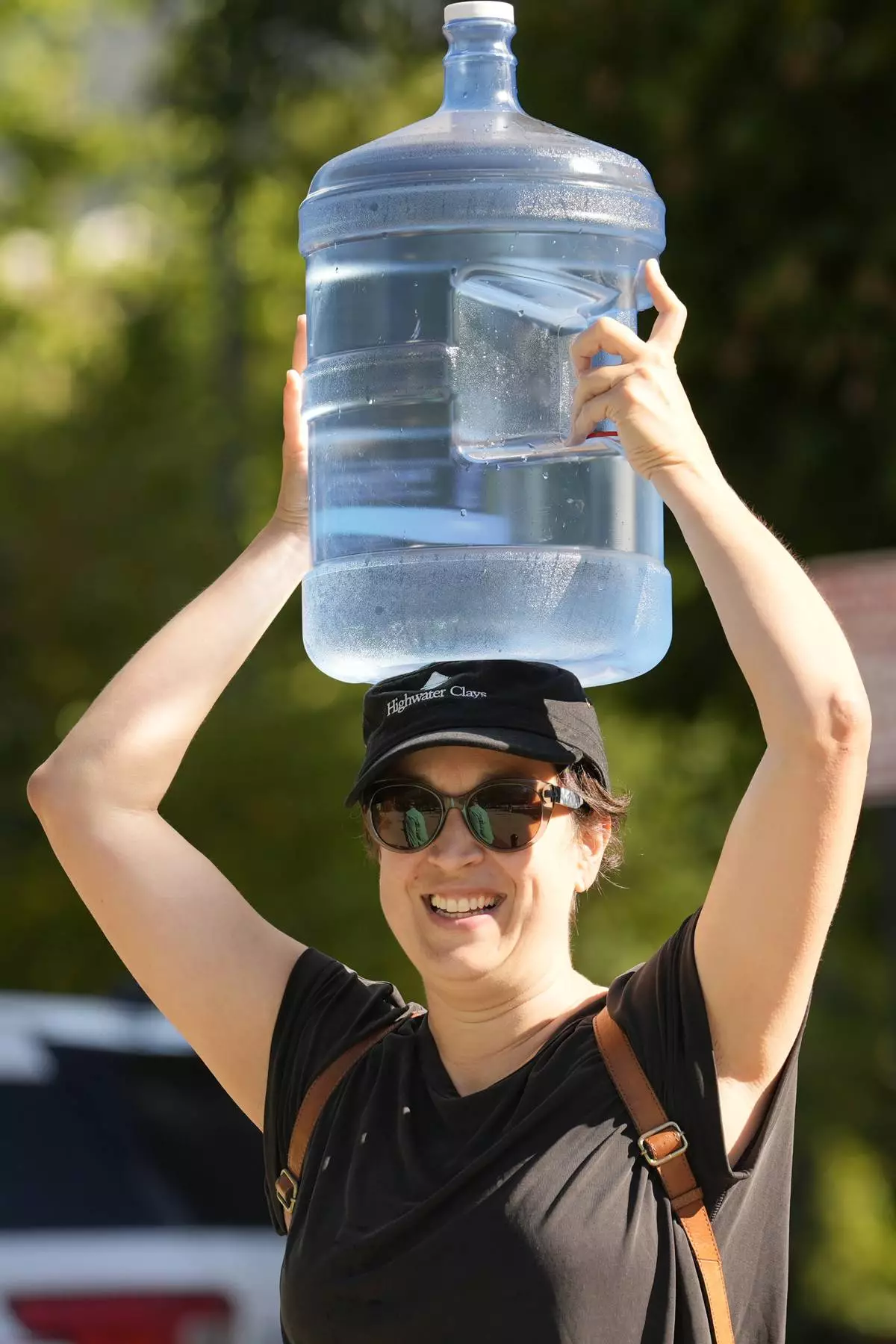
Lindsay Rust carries a jug of fresh water after filling up at a distribution site in the aftermath of Hurricane Helene Wednesday, Oct. 2, 2024, in Asheville, N.C. (AP Photo/Jeff Roberson)
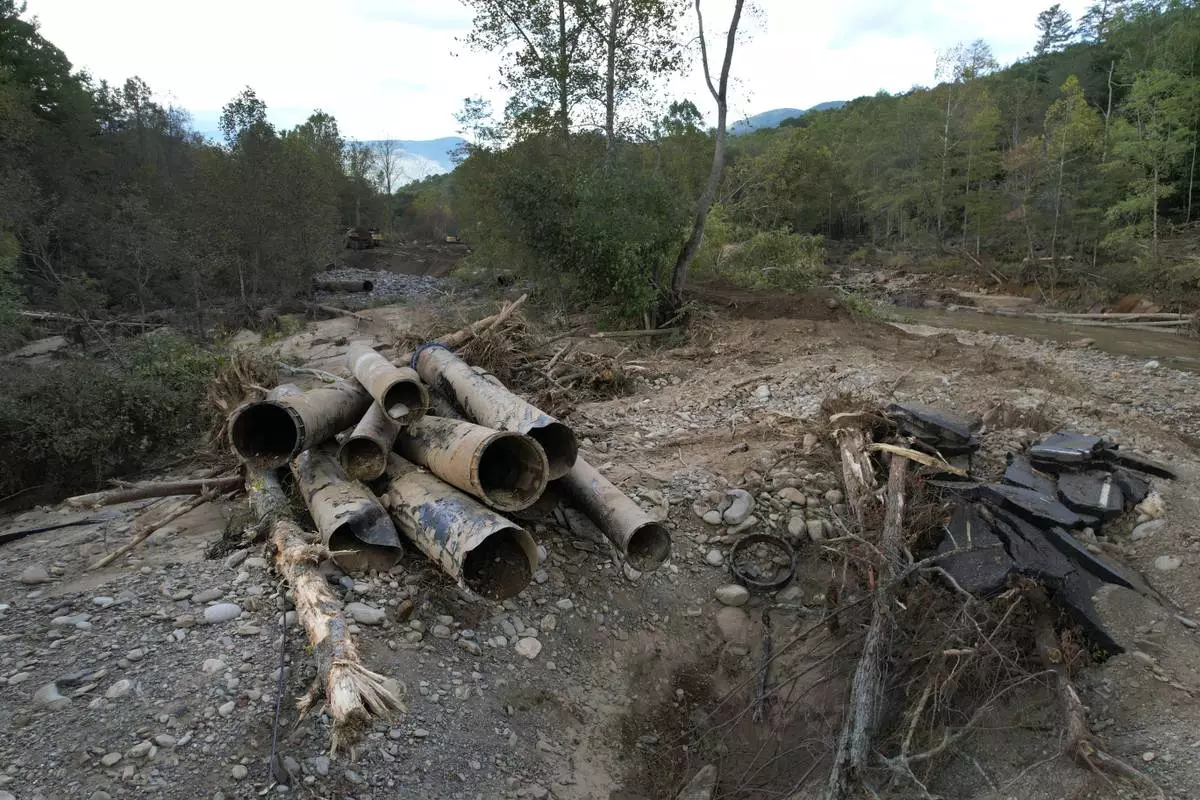
The remnants of a waterline serving Asheville, N.C., is piled up downstream from North Fork Reservoir, a main source of water for the city, Wednesday, Oct. 2, 2024, after the line was destroyed during Hurricane Helene in Black Mountain, N.C. (AP Photo/Jeff Roberson)
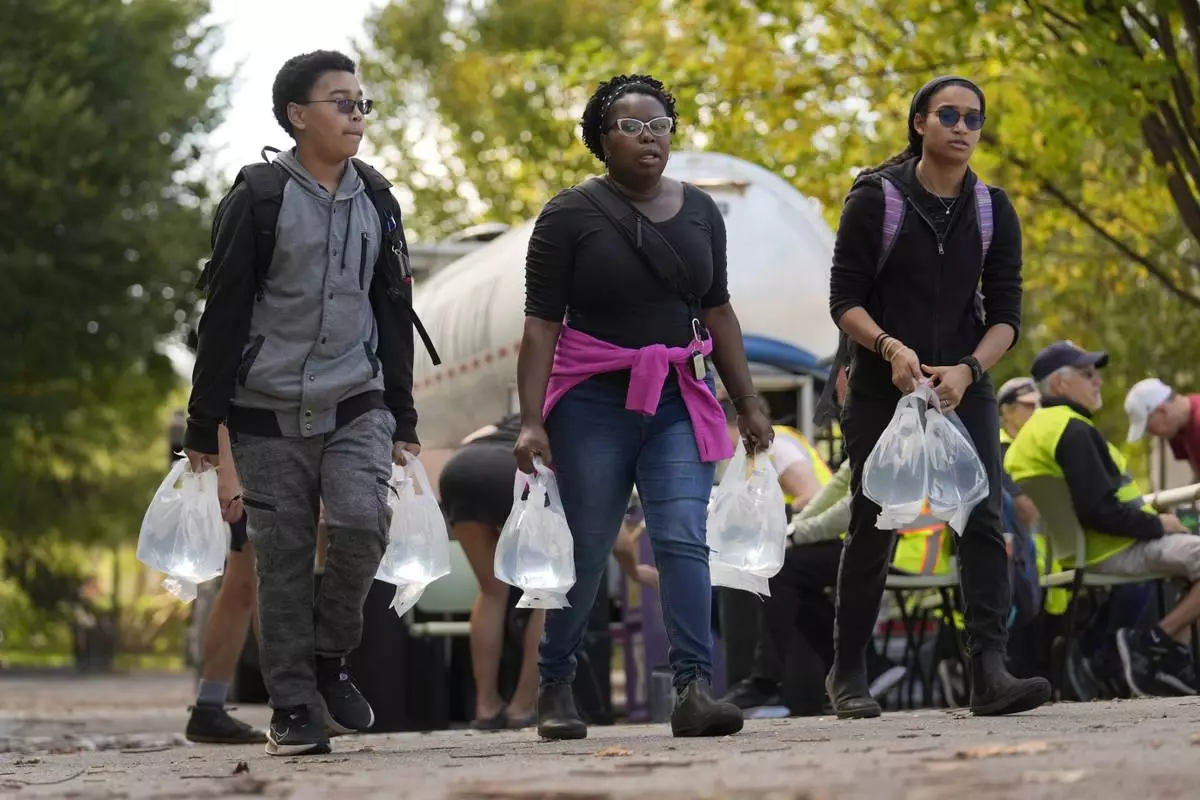
People carry bags of fresh water after filling up at a distribution site in the aftermath of Hurricane Helene Wednesday, Oct. 2, 2024, in Asheville, N.C. (AP Photo/Jeff Roberson)
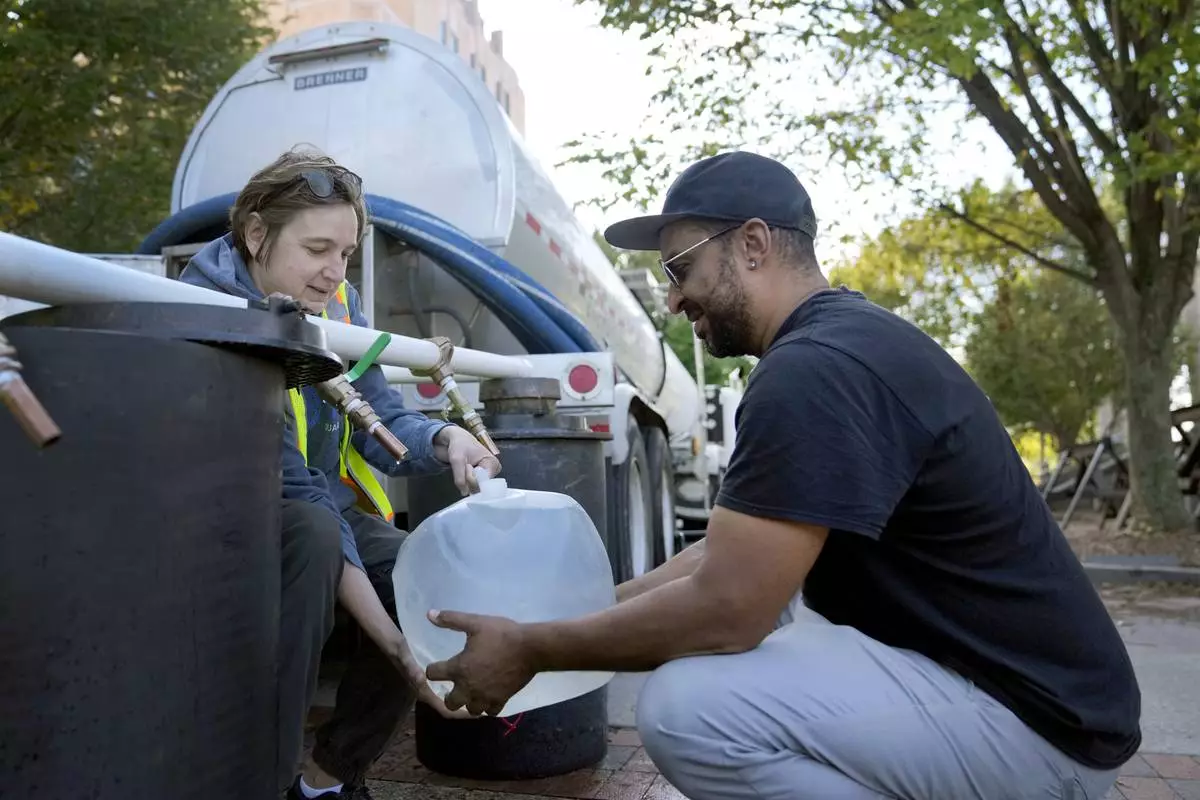
Reginald Klemz, right, fills a container of fresh water from a tanker with the help of volunteer Julie Koenke in the aftermath of Hurricane Helene Wednesday, Oct. 2, 2024, in Asheville, N.C. (AP Photo/Jeff Roberson)

Electrical contract worker Matthew Tipton looks over the remnants of a waterline serving Asheville, N.C., downstream from North Fork Reservoir, a main source of water for the city, Wednesday, Oct. 2, 2024, after the line was destroyed during Hurricane Helene in Black Mountain, N.C. (AP Photo/Jeff Roberson)
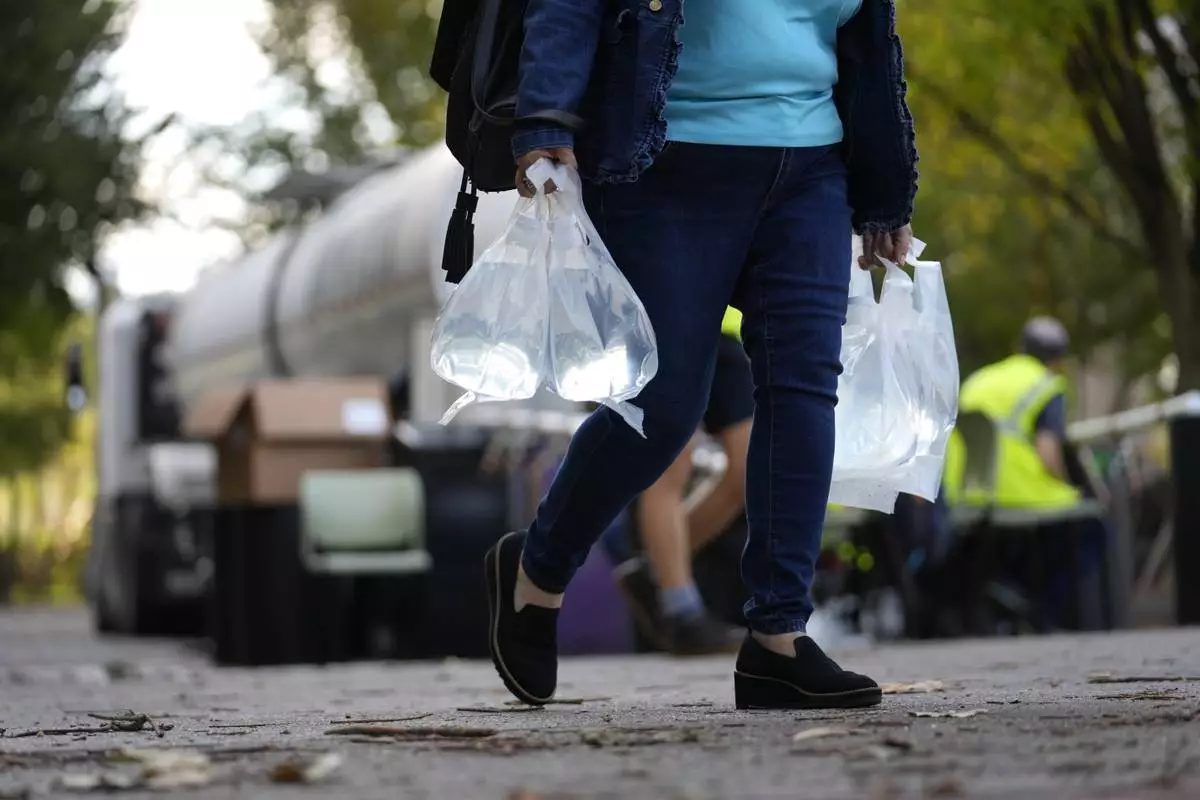
A person carries bags of fresh water after filling up from a tanker at a distribution site in the aftermath of Hurricane Helene Wednesday, Oct. 2, 2024, in Asheville, N.C. (AP Photo/Jeff Roberson)






















